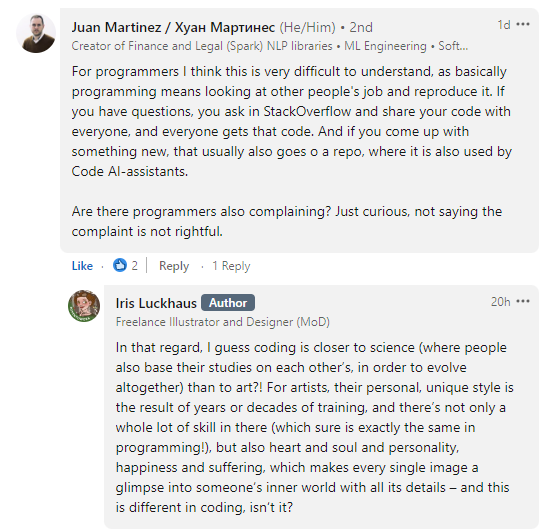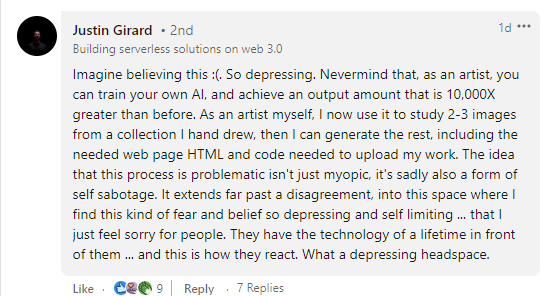AI Is[n't] Killing Artists
How to not be algorithmized away
Welcome to Polymathic Being, a place to explore counterintuitive insights across multiple domains. These essays take common topics and investigate them from different perspectives and disciplines to come up with unique insights and solutions.
Today's topic is one I’m still debating whether I should get into since it’s about social media engagement and AI. I won’t deny, I feel like I keep talking about AI when there’s so much more to look at. Yet it also highlights so many topics of human psychology that are part of the Polymathic mindset. So it makes a nice backdrop to discuss. This essay will explore a LinkedIn thread about Art and AI. While I should have known better, it still highlights the way people are reacting to this technology and why it’s so important to understand the full context. So, let’s find out how AI won’t kill the artists.

Introduction
I sometimes wonder what I’m thinking when I get into some of the online discussions. Especially those that start off with easily disprovable claims and glaring misunderstandings of human learning and psychology. The other day I thought I’d engage with a group of artists. These were mainly graphic artists and user experience types at first but then the popularity of the post brought in the photographers, videographers, and more.
The theme was simple: AI is stealing art and is going to replace real artists. I’m going to try to avoid the Con[of] Text here and not read too much emotion into these posts but I know there will be some so bear with me. The social media post in question started with the statement:
“There is no ethical way to use the major AI image generators. All of them are trained on stolen images, and all of them are built for the purpose of deskilling, disempowering and replacing real, human artists.”
In reviewing the entire discourse, I can see why it trended. The responses looked about 50/50 between artists who understand how art is really created and those who didn’t. Yet the issue is, through all the dialog, I don’t think a single artist on the anti-AI side walked away with a better understanding. They weren’t open to new insights, and it quickly became a polarizing topic.
I did learn a lot in my participation as painful as it was. It was interesting to see how split the comments were and some of the argumentation on both sides of the issue. The author copied and pasted this comment everywhere and seems to form the thesis of her argument:
This comment, suggests that skillful French cave paintings from prehistory were the first art ever created. While they are some of the oldest we’ve found, to suggest they are the first creates the cornerstone of the rest of the misunderstandings.
How is Art Created?
Many commenters challenged this view and it’s exactly what we covered in Can AI be Creative? We found there that it really can’t, but neither can most humans. Instead, we create through mimicry and by studying the greats. As Isaac Newton said:
“If I have seen further it is because I have stood on the shoulders of giants.”
That we learn socially is critically important to know and is what separates us from our primate ancestors. In the book The Secret to Our Success, author Joseph Henrich shows that a human toddler and a chimpanzee and orangutan are about the same in spatial visualization, quantities, and causality. But where humans are different is in social learning. That means building from what we see through mimicry.

One commenter homed in on the social learning aspect and contested that the claim that AI is unethical for building on other’s art means artists are in a similar boat.
He’s right, there’s even a book on the topic called Steal Like an Artist which shows how art is really derivative, combinatorial, and mimicry.
Is there Art outside of Art?
What was also fascinating to see is how artists separate themselves from the other fields in claims of unique artistic ability. When someone pointed out how so much coding is the same as art through sharing and building, it was pushed back that those coders don’t have heart and soul, and personality.
I’d say that this person has never worked with software engineers to see how much heart and soul and personality is baked into good code. It’s something we explored in The Art of STEM where I see art everywhere in STEM but many artists won’t. They want to be unique. I get that drive for differentiation, but what we see that manifesting as is an overreaction to technology.
What’s in a Tool?
Many on the thread totally understood the power that these new tools provide to the aspiring artist. Painters were panicked about photography as Mark Palmer so well points out in The Joy of Generative AI Cocreation. In the 1990s photographers then panicked about digital film and then cell phone cameras. Today millions of people can take photos that were limited to only professionals with expensive equipment. Yet there are not fewer photographers or less art. There’s more!
As this next comment aptly states, it is depressing that people view the tool of AI as limiting versus enabling even more art to be created faster:
The Underlying Issues
Soon the conversation took that classic social media downturn where the logical fallacies start to turn personal. After one discussion about deskilling and replacing artists, I shared that I’d just been able to create my own novel cover and was promptly attacked as not being an artist. Not a real artist… because they’re unique and special.

That one comment about distilling my novel down into a one-line summary demonstrates how little many of them know about what art actually is. Sure, you could distill it down and learn the ending, but you’d miss the characters, the drama, and the feeling that existed. You’d miss the heart and soul and personality of the writing. But that exists outside of art too. If you only look at software as code, and not the details that are in it and what it can do as an output, you miss the art.
It does highlight another point in what I learned. Not only do people not understand how we create art and how art is created in technology, but we learn that they’d use technology to distill art down to nothing. Maybe that’s their real angst because they are expecting from others what they’d expect from themselves.
Because if they were on the other side, they might be deskilling and replacing the humans if they had a chance. They aren’t looking at the technology, they’re looking at a mirror and that is one of the most important lessons I’ve had to learn in these engagements. Birgitte Rasine captures this in the fantastic essay which lines up with my own ideas about a societal autoimmune response and that it's:
One human telling another human they are no longer valued—because they weren’t truly valued to begin with.
The irony of my engagement on that social media post was that the very people who were the most worried about being replaced were the first to tell me that I wasn’t valued as an artist or a writer. They really were looking into the mirror I think.
Summary
The main lesson I learned is these posts aren’t there for learning (which was obvious from the post itself) but you can still learn a lot about how people are interpreting technology and the whole system around it. It highlights a total lack of systems thinking to contextualize how we learn, create, imagine, and build. It creates a false binary of Art vs Technology that doesn’t exist. It views a tool as a threat while ignoring all the other tools they currently use because they are familiar with it.
I’d also add that a real artist isn’t one who can be algorithmized away. Those fearing that AI Art and Text generators will take their jobs are probably right. The key is to create a skill set that can’t be automated away. This is a harder challenge and one I’ll be poking at in future essays. Fundamentally, the future of art and science is Polymathic as we continue to add tools that can help unlock even more innovation.
Enjoyed this post? Hit the ❤️ button above or below because it helps more people discover Substacks like this one and that’s a great thing. Also please share here or in your network to help us grow.
Polymathic Being is a reader-supported publication. To receive new posts and support my work, consider becoming a free or paid subscriber.
Further Reading from Authors I really appreciate
I highly recommend the following Substacks for their great content and complementary explorations of topics that Polymathic Being shares.
Looking for other great newsletters and blogs? Try The Sample
Every morning, The Sample sends you an article from a blog or newsletter that matches up with your interests. When you get one you like, you can subscribe to the writer with one click. Sign up here.
Update 10












An artist should be someone who simply participates in and appreciates creative processes. But a lot of them don’t appreciate it if there’s too much competition. If you want to categorize people in skill groups and identify every sort of tool that can be used in fairness… that would make it a sport.
But right now we have it that an artist is someone who blames everything else for not being able to compete in the same heat as literally hundreds of millions of other artists with or without the assist of technology. And that’s called natural selection.
The replies you got on Linkedin cracked me up! “You are no artist in the professional sense: nobody would pay you.” 🤣🤣
I sense a lot of fear and anxiety in those answers. Fear that what I enjoy doing and is my livelihood will be “taken away” from me.
Completely agree that there is art in software development. We previously discussed how good technical documentation is a work of art (both the writing and the visuals). Good code and design is also a work of art — some of the libraries written by my colleagues were fun to work with, others were soul crushing.
I want to test whether I can engage constructively on other platforms with people who hold completely different viewpoints on polarizing issues. I have just started posting on both r/climatechange and r/climateskeptics. We’ll see how that goes!